

Maximize Fluorescence Performance for Up to 40% More Signal in High-Sensitivity Imaging Systems
Push Fluorescence Sensitivity Further with Our Semrock® Avant™ Filter Set Family
Engineered for demanding fluorescence applications, our Semrock Avant Filter Sets deliver up to 40% more fluorescence performance through steeper edges and optimized crossover design. Each set is precisely tuned to amplify signal, maximize brightness, and improve overall throughput, even with short Stokes Shift fluorophores.
Talk to an Expert Shop Avant Filters Shop Avant Filter Sets
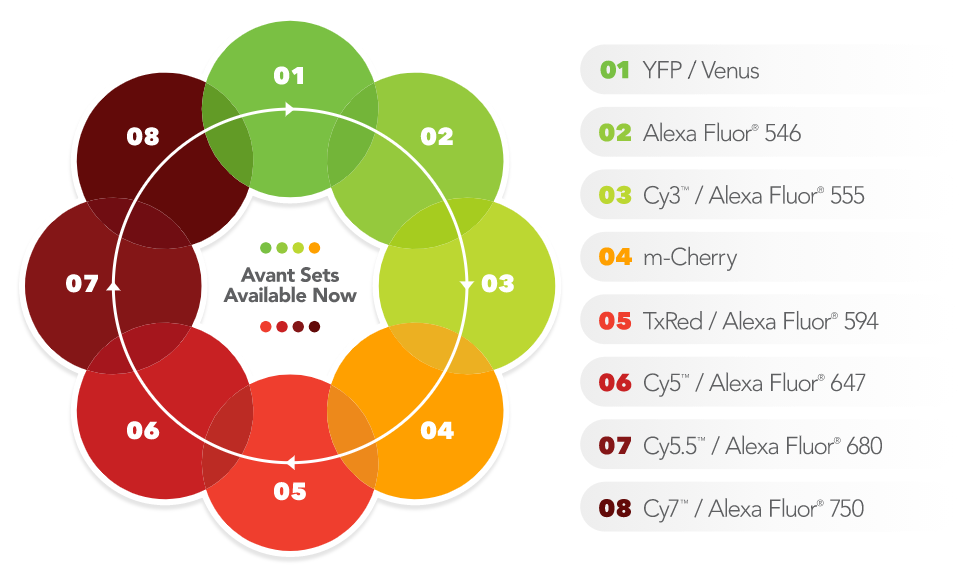
Overcoming the Limits of Traditional Filter Sets
Traditional fluorescence filter sets have long faced a trade-off between light throughput and unwanted bleedthrough at the crossover point between excitation and emission bands. Our Semrock Avant Filter Set Family was engineered to resolve this limitation. Through precise control of edge placement and crossover geometry, Avant filters enable higher signal capture and improved fluorescence performance compared to standard designs.
The Avant Advantage
Steeper Edges. Higher Transmission. Tighter Control.
Our Avant filter sets represent the next generation of fluorescence performance. Through proprietary manufacturing processes and advanced metrology, we give you:
Sharper Transitions
Sharper transitions between excitation and emission bands for cleaner separation.
Higher Signal-to-Noise Ratios
Higher signal-to-noise ratios through reduced bleedthrough and reflection.
Enhanced Throughput
Enhanced throughput without compromising blocking performance.
Precision Alignment
Precision alignment of filter edge positions for optimized spectral efficiency.
Proven Results in Performance
Independent modeling and in-house testing confirmed significant gains in signal intensity and measurement accuracy.
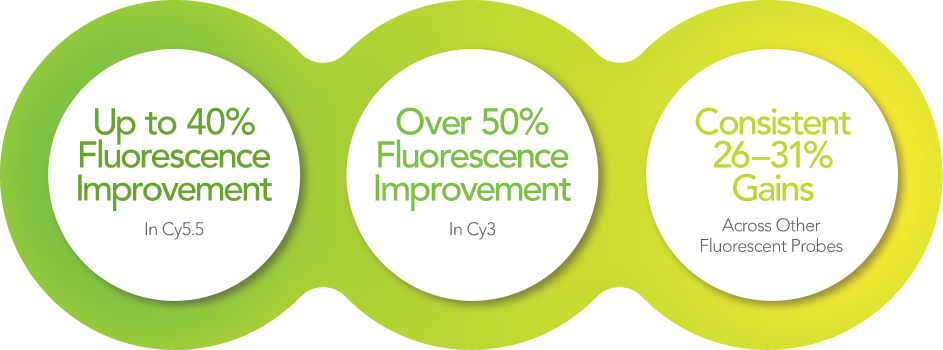
Designed for Demanding Applications
Our Avant Filter Sets are built for fluorescence systems that demand precise spectral control, high signal-to-noise, and reliable performance across a wide range of fluorophores.
READY TO ELEVATE YOUR FLUORESCENCE PERFORMANCE?
Connect with our optical experts to discuss your application needs, or explore available Avant Filter Sets online.
From Concept to Capability
Discover the optical principles behind our Avant Filter Set design and see how precise edge control and crossover optimization translate into measurable fluorescence performance gains.
Engineering a Better Fluorescence Filter
A fluorescence filter set as used in biological microscopy consists of the following:
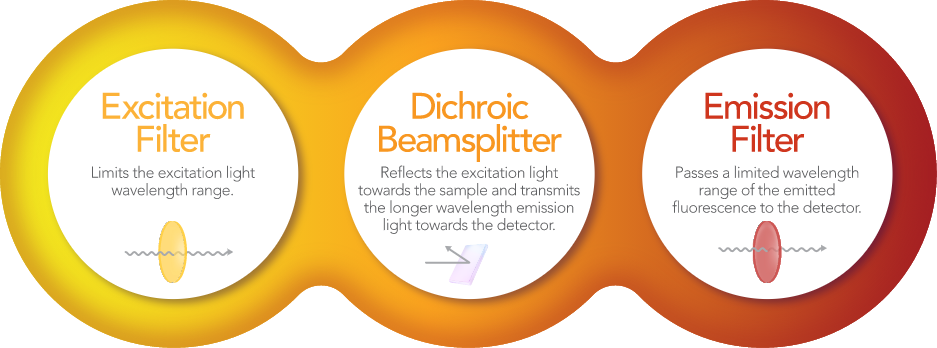
The excitation passband is placed over the excitation spectrum for the fluorophore, and the emission passband, over the emission spectrum. The issue here is the optimal placement of these passbands and how that can depend on the size of the Stokes Shift.
The Stokes Shift is the separation in wavelength between peak excitation and emission wavelengths. Fluorophores with large Stokes Shifts have widely separated excitation and emission peaks, and the filter passbands can be centered on the peak excitation and emission wavelengths to optimize for maximum emission signal and minimum excitation light bleedthrough into the emission channel. However, the popular short Stokes Shift fluorophores have filter passband edges placed close together, and compromises between signal and bleedthrough have therefore often been required, as shown below.
The usual arrangement of filter passbands for short Stokes Shift fluorophores is shown schematically in Fig. 1. The excitation and emission spectral edges lying closest to the crossover wavelength are known as the ‘critical edges.’ In current practice, the so-called Gap between the critical edges is usually located quite asymmetrically with respect to the crossover wavelength for the fluorophore. This asymmetry pushes the emitter passband out to longer wavelengths, resulting in less emission light capture by the emission filter and therefore reduced filter set performance.
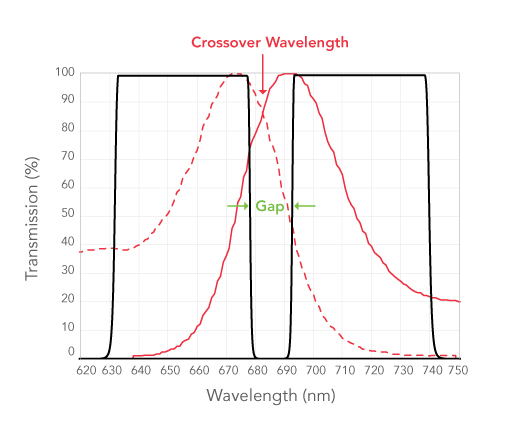
Figure 1: Schematic excitation (dashed red line) and emission (solid red line) spectra for a fluorophore with corresponding excitation and emission filters (solid black lines).
The Gap has been difficult to reduce for two reasons. First, the narrow Gap associated with short Stokes Shift fluorophores has resulted in higher levels of excitation light bleedthrough, i.e., excitation light reflected from the specimen plane into the emission filter. Second, the two critical edges must not be placed too close together, as shifts in their positions due to variations in production could result in reduced blocking. Though Semrock filters have been offering best-in-class consistency of this edge placement within and between production batches, closer placement of the critical edges requires an unprecedented improvement in precision of edge placement in production.
Because the described performance deficit holds for a significant number of popular short Stokes Shift fluorophores, there is systematic underperformance of corresponding filter sets over the industry. As IDEX Health & Science has recently made strides in improving the Semrock optical filter coating performance and metrology capabilities, we set out to improve the performance of filter sets for short Stokes Shift fluorophores, i.e., those with less than 3% Shift relative to the crossover wavelength. These improvements are now available in the Avant Filter Set Family.
How Avant Redefines Filter Design
Three steps were used to avoid the limitations described above:
Steeper Edges
The critical edges were significantly steepened from their versions in standard filter sets.
Closer Edges
Once the edges were steepened, the critical edges were moved closer together.
Deeper Blocking
Deep complementary blocking (OD 10, Design Specification) was implemented in both exciter and emitter to suppress excitation light bleed-through.
Recent key, proprietary advances at Semrock made this possible:
- Steeper critical edges were made possible by improvements in control of the filter coating process.
- The placement of the critical edges with increased accuracy was made possible by the Precise Edge Placement capability, which results in tightened statistical distribution of edge positions.
- The KolaDeep™ Spectral Measurement System, with its ability to measure OD down to OD 8 or better and to resolve edges steeper than 0.2% of the edge wavelength, was used to confirm critical edge characteristics.
Proven Results in Fluorescence Performance
An example is shown in Fig. 2, which shows the modeled increase in fluorescence emission signal for the Cy5.5 fluorophore. Note the improved position of the Gap, now placed symmetrically with respect to the crossover point.
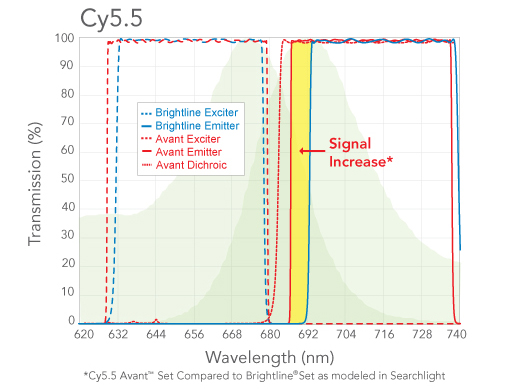
Figure 2: The Avant filter set for Cy5.5 (red lines) increase the signal compared to the Brightline (blue lines) filter set.
Modeling was performed using the SearchLight simulation tool using measured spectra of the new filter sets, summarized in Table 1. The fluorescence improvement is significant, as shown in the rightmost column, and the excitation light bleedthrough (shown in the column to the left of the fluorescence percent increase) has been effectively eliminated.
| Fluorescent Probe | Excitation Source | Filter Set | Fluorescence Signal × 10-6 | Excitation Light Bleedthrough × 10-9 | Fluorescence Signal Improvement with Avant |
|---|---|---|---|---|---|
| Venus | 510 nm LED (X-Cite NOVEM) | LED-Venus-A Avant Venus-YFP | 3.53 4.54 | 1.15 < 10-4 | 29% |
| Cy3 | 555 nm LED (X-Cite NOVEM) | Cy3-4040C Avant Cy3 | 2.79 4.63 | 0.65 < 10-4 | > 50% |
| Cy5.5 | 655 nm Lumiled LXM3-PD01 | Cy5.5-C Avant Cy5.5 | 1.76 2.30 | 1.20 < 10-4 | 31% |
| Cy7 | 740 nm CoolLED | LED-Cy7-A Avant Cy7 | 4.28 5.38 | 5.20 < 10-4 | 26% |
Early results from a Semrock optical filter customer using Cy5.5 showed an increase of greater than 40% in fluorescence signal over background when the Cy5.5 Avant filter set was used in comparison to an incumbent filter set.
Maximized Fluorescence Performance
The Avant Filter Set Family delivers improved fluorescence signal and signal-to-noise ratio to application areas that prioritize efficiency, speed, and performance in single-band filter sets. In addition, this new Avant technology is now available for custom filter and filter set design. We welcome inquiries from all OEM developers of fluorescence-based tools.
![]()
PLANNING YOUR NEXT FLUORESCENCE FILTER SETUP? START HERE.
Fill out a short form and our team will connect you with an optical expert who can help evaluate your needs and guide next steps.


